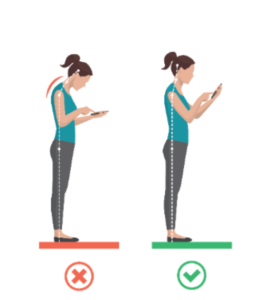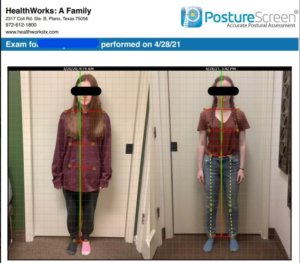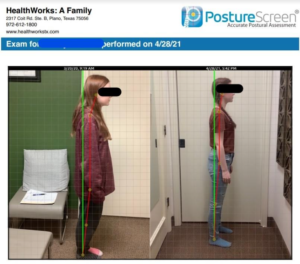Posture and your teen: Not just about looking good.
Correcting a teen’s posture seems like an age-old right of passage for both parent and teen. Sit up straight! Stop slumping! These are just a couple that I still hear my mother saying and I find myself saying to my own kids.
However, good posture is not simply a way to look more alert, confident (although this IS an issue and will be mentioned later), and “taller” for those out there that are vertically challenged but having poor posture can actually be detrimental to your health; especially as we age.
Obviously, most parents are unaware of how posture and health are related, so here are some health issues that are directly linked to poor posture over time:
- Chronic and acute pain of the back, neck, and shoulder
- Headaches
- Knee, hip, and back injuries
- Respiration problems
- Stiffness
- Fatigue
- Muscle atrophy and weakness
- Digestive problems
- Sciatica
- Formation of varicose veins or “spider” veins
- Impingement and nerve compression
- Carpal tunnel syndrome
How many of these issues have you already seen in your teens or young adults? It goes without saying, that we are seeing these issues younger and younger these days and much of it has to do with the fact that we rely on technology so much in our everyday lives that we have become more sedentary than ever before.
Hey Boomer and GenX! Do you remember a time when sitting down all day at a computer wasn’t a “thing”? Oh yes, the good old days when we had to look things up in books, card catalogs and Microfiche! Ok, not saying that technology hasn’t made things more convenient, we’ve just become lazy and the spines, nervous systems and health of our kids are really suffering from the instant gratification of this technology.
Does this look familiar?
This is the most common sight now seen on school campuses and anywhere a congregation of teens can be found—ok, maybe not the mall anymore, I mean where do they go these days???
The aches and pains that were once only common in older adults are starting to manifest as young as 4 years old! Migraines and headaches are now found in 3% of children of preschool children, 4% to 11% of elementary school-aged children, and 8% to 15% of high school-aged children according to the Cleveland Clinc!
Digestive Distress
How many teens and young adults do you know that suffer from these ailments? Yup! Not just for grandma and grandpa anymore—these issues are becoming serious issues at a younger and younger age.
- Constipation
- IBS
- Acid reflux
- Hernias
- Incontinence
These issues are caused by compression of the internal organs and of the abdomen. Correct posture permits these organs to maintain their natural position. When the upper body is rounded or in a slouched position, the rib cage and diaphragm muscles are unable to expand properly. Slouching postures can also lead to nerve impingements, lessening the ability of nerves to relay signals between our brain and body, leading to a less than optimal function of all the organs in the abdomen—which are many!
According to Meghan Markowski, a physical therapist at Harvard-affiliated Brigham and Women’s Hospital, “Researchers are also looking into whether posture affects mood, sleep, fatigue, and jaw alignment,”. So, let’s take a look at these issues. Raise your hand if you would like your teen to be in a better mood and not fight you tooth and nail to get up in the morning???
Yeah, I thought so!
Body Language, Negative Emotions and Poor Sleep
We all know that first impressions count and posture says a lot about personality. When teens and young adults exhibit good posture, like holding their head up, and standing tall with an open chest it exudes confidence even though they may not feel that way inside. A slouched and lazy posture indicates disinterested body language which can negatively affect a variety of things, again, whether or not they are feeling poorly or not. Poor posture can inadvertently give off a number of negative cues such as:
- lack of confidence
- laziness/lack of motivation
- depression
- lack of personal care
A recent study was published in Health Psychology, where researchers monitored the effects of slumped or straightened posture on a group of 74 people. Each of the study participants were strapped into their assigned posture, either slumped or straightened and then asked to perform a series of tasks. Their blood pressure and heart rate were constantly measured throughout. The results showed the following:
“Upright participants reported higher self-esteem, more arousal, better mood, and lower fear, compared to slumped participants. Linguistic analysis showed slumped participants used more negative emotion words, first-person singular pronouns, affective process words, sadness words, and fewer positive emotion words and total words during the speech. Upright participants had higher pulse pressure during and after the stressor.”
How to get your teen to finally sit up straight—not bad advice for parents either…just sayin’
- Corrective Chiropractic Care
- Exercises
- Cervical Traction/Spinal Molding Exercises
- Better Computer and Cell Phone Ergonomics
What exactly is corrective chiropractic care?
Corrective chiropractic care primarily focuses on the structure and function of your spine. Only 10% of the nerves in your body can sense pain. The other 90% of the nerves control the function of everything in your body. If you have a misalignment in your spine that is causing pain or a postural issue, it is likely that you have had a long-standing problem that has been affecting your function as well. In addition to the proper motion and position of the individual spinal bones, corrective chiropractic care focuses on the proper curvature of the spine. When looking at the spine from the side, there should be three distinct curves; forward in the neck, backward in the mid back, and forward in the low back. If there is deviation of these curves from normal, it can create abnormal tension on the brainstem and spinal cord, thereby creating dysfunction of the nervous system, resulting in neck or back pain, headaches, migraines and significant postural abnormalities that can cause many other symptoms that disrupt nerve signals to different organs within your body and affecting your overall health as mentioned above.
Analyzing the structure and function of your spine requires specific X-rays to view the curvature of the spine and the function of each bone in relation to the ones above and below. This is especially important in the upper cervical spine at the skull, atlas (C1) and the axis (C2). At this region is where the postural muscles get all of their information on how to function properly. HealthWorks utilizes a very gentle and specific technique that focuses on this region in which once it’s aligned properly, can provide significant and instant changes in posture!
Our F3 exam (form, function, and findings) will give the information necessary to determine the proper treatment plan to provide the most specific correction possible, rather than merely chasing symptoms.
Traditional chiropractic care focuses just on acute symptoms, which is initially very important. However, our approach will not only focus on the acute issues, but also on the cause of poor posture and the subsequent health issues that could or already are manifesting in your teen or young adult before it becomes a major health issue later in life. Wouldn’t it be great if they didn’t suffer the same issues you have as an adult? Wouldn’t you have loved it if your parents knew what you know now?
Exercises
HealthWorks provides very specific exercises based upon pre and post postural changes after the initial alignment. However, there are many things that you and your teen can start right now to get things going on the right track. Note: If these exercises are difficult or worse, painful, it may be a sign that there is a significant misalignment in the upper neck that is causing abnormal signals to the muscles that are responsible for a balanced and strong posture.
- Cat-Cow
https://www.youtube.com/watch?v=7hv4u5sQD7k
- Wall Exercise
https://www.youtube.com/watch?v=S6dJf_OHdPA
- Range of motion (neck & torso)
https://www.youtube.com/watch?v=VejPPTN3nlw
https://www.youtube.com/watch?v=OX-nz5bZpMM
Cervical traction/Spinal molding exercises
This is one of the exercises we teach to our patients and do not recommend just starting this on your own. It may just look like you are lying on a pillow, but it does so much more and with some patients it may take some time to get up to the full fifteen minutes. Careful observation by HealthWorks chiropractors and our therapy techs is necessary to gain the most from this exercise.
Better Computer and Cell Phone Ergonomics
Let’s face it, technology is not going away and will become more and more integrated into our everyday lives even if we are kicking and screaming the entire way—ok, just me? Yeah, I’m old school and if it all went away tomorrow I would gladly go back to 1983, but a girl can only hope. Let’s just face reality and realize that our teens and young adults have never lived in a world without computers and cell phones and desperately need workspaces and lessons in ergonomics to combat the poor posture these devices perpetuate.
A comfortable workstation setup promotes neutral postures with the neck aligned with the spine (neutral – not bent or thrust forward), back relaxed but supported, shoulders relaxed (not hunched or rounded), elbows close to the body and bent at an angle between 90 and 120 degrees, and wrists and hands straight (not bent or turned).
If you don’t have a computer desk or you are using a laptop, here is an easy fix for you and your teen:
Cells phones are a little more challenging—especially since it’s so convenient and with some of our teens, surgically attached to them! Here is the proper position to make a habit on a regular basis. As tough as it may be, it’s essential for good posture and a healthy spine and nervous system and avoid the “cell phone slump”.
Hold the phone at eye level. Not only will this allow you to avoid the slouch, but it will keep your teen from using your cell phone for to long, causing the mind-numbing, glazed-face, fog-brain and constant, “huh’s” we get from them on a regular basis. Win-win for everyone!
We have many success stories with our patient’s, but one does stick out when it comes to teens, posture and pain. Kathryn came in with severe hip pain and her mom was very concerned about her posture especially since scoliosis runs in her family. She has been diligent with her corrective chiropractic care and exercises and these are her results.
Needless to say, both mom and teen were not only happy that her hip pain was a distant memory, but the posture changes were an added bonus!
Our promise to you
HealthWorks is dedicated to comprehensive and specific approach to taking care of spinal and nervous system needs. Let us help you and your teen find out how taking care of the most important system in the body will create optimal health that will last a lifetime!
References:
- Cleves C, Rothner AD. Headache in Children and Adolescents: Evaluation and Diagnosis, including Migraine and its Subtypes. Chapter 6. In: Tepper SJ, Tepper DE, eds. The Cleveland Clinic Manual of Headache Therapy. New York: Springer 2011:81-92.
- https://www.health.harvard.edu/staying-healthy/3-surprising-risks-of-poor-posture
- Nair S, Sagar M, Sollers J 3rd, Consedine N, Broadbent E. Do slumped and upright postures affect stress responses? A randomized trial. Health Psychol. 2015 Jun;34(6):632-41. doi: 10.1037/hea0000146. Epub 2014 Sep 15. PMID: 25222091.






